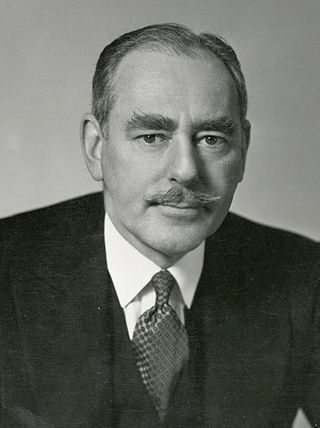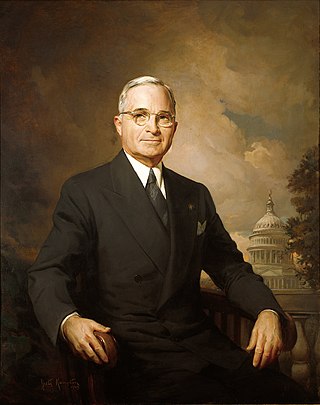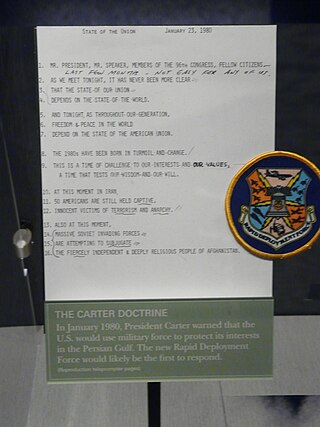
Dean Gooderham Acheson was an American statesman and lawyer. As the 51st U.S. Secretary of State, he set the foreign policy of the Harry S. Truman administration from 1949 to 1953. He was also Truman's main foreign policy advisor from 1945 to 1947, especially regarding the Cold War. Acheson helped design the Truman Doctrine and the Marshall Plan, as well as the North Atlantic Treaty Organization. He was in private law practice from July 1947 to December 1948. After 1949 Acheson came under partisan political attack from Republicans led by Senator Joseph McCarthy over Truman's policy toward the People's Republic of China.

The Truman Doctrine is an American foreign policy that pledges American "support for democracies against authoritarian threats." The doctrine originated with the primary goal of containing Soviet geopolitical expansion during the Cold War. It was announced to Congress by President Harry S. Truman on March 12, 1947, and further developed on July 4, 1948, when he pledged to contain the communist uprisings in Greece and Soviet demands from Turkey. More generally, the Truman Doctrine implied American support for other nations threatened by Moscow. It became the foundation of American foreign policy, and led, in 1949, to the formation of NATO. Historians often use Truman's speech to Congress on March 12, 1947 to date the start of the Cold War.

The Carter Doctrine was a policy proclaimed by President of the United States Jimmy Carter in his State of the Union Address on January 23, 1980, which stated that the United States would use military force, if necessary, to defend its national interests in the Persian Gulf. It was a response to the Soviet Union's intervention in Afghanistan in 1979, and it was intended to deter the Soviet Union, the United States' Cold War adversary, from seeking hegemony in the Persian Gulf region.

The Reagan Doctrine was stated by United States President Ronald Reagan in his State of the Union address on February 6, 1985: "We must not break faith with those who are risking their lives—on every continent from Afghanistan to Nicaragua—to defy Soviet-supported aggression and secure rights which have been ours from birth." It was a strategy implemented by the Reagan Administration to overwhelm the global influence of the Soviet Union in the late Cold War. The doctrine was a centerpiece of United States foreign policy from the early 1980s until the end of the Cold War in 1991.

Henry Agard Wallace was an American politician, journalist, farmer, and businessman who served as the 33rd vice president of the United States, under President Franklin D. Roosevelt. He served as the 11th U.S. secretary of agriculture and the 10th U.S. secretary of commerce. He was the nominee of the new Progressive Party in the 1948 presidential election.

For the United States, 1945–1964 was a time of high economic growth and general prosperity. It was also a time of confrontation as the capitalist United States and its allies politically opposed the Soviet Union and other communist states; the Cold War had begun. African Americans united and organized, and a triumph of the civil rights movement ended Jim Crow segregation in the Southern United States. Further laws were passed that made discrimination illegal and provided federal oversight to guarantee voting rights.
Americans for Democratic Action (ADA) is a liberal American political organization advocating progressive policies. ADA views itself as supporting social and economic justice through lobbying, grassroots organizing, research, and supporting progressive candidates.

Containment was a geopolitical strategic foreign policy pursued by the United States during the Cold War to prevent the spread of communism after the end of World War II. The name was loosely related to the term cordon sanitaire, which was containment of the Soviet Union in the interwar period.
A United States presidential doctrine comprises the key goals, attitudes, or stances for United States foreign affairs outlined by a president. Most presidential doctrines are related to the Cold War. Though many U.S. presidents had themes related to their handling of foreign policy, the term doctrine generally applies to presidents such as James Monroe, Harry S. Truman, Richard Nixon, Jimmy Carter and Ronald Reagan, all of whom had doctrines which more completely characterized their foreign policy.

Harry S. Truman was an American politician and farmer who served as the 33rd president of the United States, serving from 1945 to 1953. A member of the Democratic Party, he previously served as the 34th vice president from January to April 1945 under Franklin D. Roosevelt and as a United States senator from Missouri from 1935 to January 1945. Assuming the presidency after Roosevelt's death, Truman implemented the Marshall Plan to rebuild the economy of Western Europe and established both the Truman Doctrine and NATO to contain the expansion of Soviet communism. He proposed numerous liberal domestic reforms, but few were enacted by the conservative coalition that dominated the Congress.
There were people and organizations who predicted that the USSR would dissolve before the eventual dissolution of the USSR in 1991.
In United States politics, modern liberalism is a form of social liberalism that is one of two current major political factions in the United States. It combines ideas of civil liberty and equality with support for social justice. Economically, modern liberalism supports government regulation on private industry and opposes corporate monopolies. It opposes cuts to the social safety net, while simultaneously promoting income-proportional tax reform policies to reduce deficits. It supports a role for government in reducing economic inequality, increasing diversity, providing access to education, ensuring healthcare, regulating economic activity, and protecting the natural environment. This form of liberalism took shape in the 20th century as the voting franchise and other civil rights were extended to a larger class of citizens, most notably among African Americans and women. Major examples of modern liberal policy programs include the New Deal, the Fair Deal, the New Frontier, the Great Society, the Affordable Care Act, and the Infrastructure Investment and Jobs Act.
Liberalism in the United States is based on concepts of unalienable rights of the individual. The fundamental liberal ideals of freedom of speech, freedom of the press, freedom of religion, the separation of church and state, the right to due process, and equality under the law are widely accepted as a common foundation of liberalism. It differs from liberalism worldwide because the United States has never had a resident hereditary aristocracy, and avoided much of the class warfare that characterized Europe. According to American philosopher Ian Adams, "all U.S. parties are liberal and always have been. Essentially they espouse classical liberalism, that is a form of democratised [sic] Whig constitutionalism plus the free market. The point of difference comes with the influence of social liberalism and the proper role of government."

This bibliography of Harry S. Truman is a selective list of scholarly works about Harry S. Truman, the thirty-third president of the United States (1945–1953). See also the bibliographies at Harry S. Truman, Presidency of Harry S. Truman, and Foreign policy of the Harry S. Truman administration.

Harry S. Truman's tenure as the 33rd president of the United States began on April 12, 1945, upon the death of Franklin D. Roosevelt, and ended on January 20, 1953. He had been vice president for only 82 days. A Democrat from Missouri, he ran for and won a full four–year term in the 1948 election. Although exempted from the newly ratified Twenty-second Amendment, Truman did not run again in the 1952 election because of his low popularity. He was succeeded by Republican Dwight D. Eisenhower in 1953.

This timeline of modern American conservatism lists important events, developments and occurrences which have significantly affected conservatism in the United States. With the decline of the conservative wing of the Democratic Party after 1960, the movement is most closely associated with the Republican Party (GOP). Economic conservatives favor less government regulation, lower taxes and weaker labor unions while social conservatives focus on moral issues and neoconservatives focus on democracy worldwide. Conservatives generally distrust the United Nations and Europe and apart from the libertarian wing favor a strong military and give enthusiastic support to Israel.
There has never been a national political party in the United States called the Conservative Party. All major American political parties support republicanism and the basic classical liberal ideals on which the country was founded in 1776, emphasizing liberty, the pursuit of happiness, the rule of law, the consent of the governed, opposition to aristocracy and fear of corruption, coupled with equal rights before the law. Political divisions inside the United States often seemed minor or trivial to Europeans, where the divide between the Left and the Right led to violent political polarization, starting with the French Revolution.

The 1948 Progressive National Convention was held in Philadelphia from July 23–25, 1948. The convention ratified the candidacies of former Vice President Henry A. Wallace from Iowa for president and U.S. Senator Glen H. Taylor of Idaho for vice president. The Progressive Party's platform opposed the Cold War and emphasized foreign policy.

The main issues of the United States foreign policy during the 1945–1953 presidency of Harry S. Truman include:

The Cold War from 1947 to 1948 is the period within the Cold War from the Truman Doctrine in 1947 to the incapacitation of the Allied Control Council in 1948. The Cold War emerged in Europe a few years after the successful US–USSR–UK coalition won World War II in Europe, and extended to 1989–1991. It took place worldwide, but it had a partially different timing outside Europe. Some conflicts between the West and the USSR appeared earlier. In 1945–1946 the US and UK strongly protested Soviet political takeover efforts in Eastern Europe and Iran, while the hunt for Soviet spies made the tensions more visible. However, historians emphasize the decisive break between the US–UK and the USSR came in 1947–1948 over such issues as the Truman Doctrine, the Marshall Plan and the breakdown of cooperation in governing occupied Germany by the Allied Control Council. In 1947, Bernard Baruch, the multimillionaire financier and adviser to presidents from Woodrow Wilson to Harry S. Truman, coined the term "Cold War" to describe the increasingly chilly relations between three World War II Allies: the United States and British Empire together with the Soviet Union.











